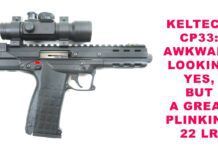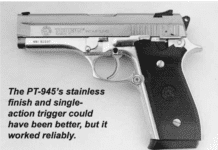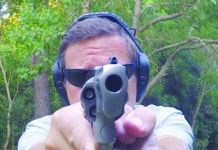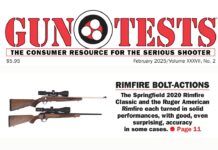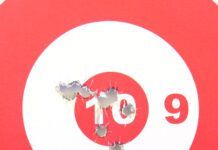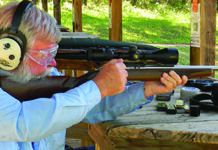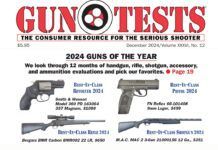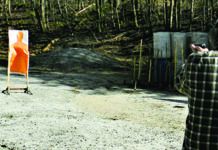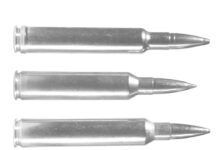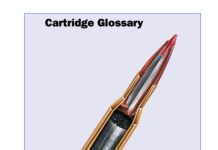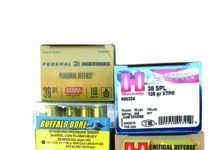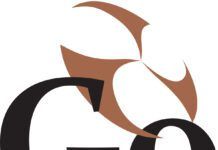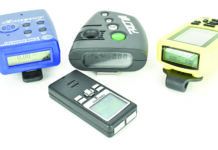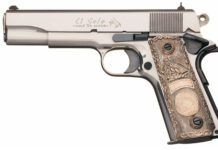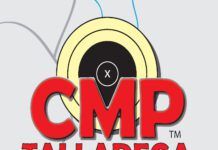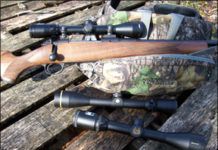New Wild Boar Series Bags Now Available From Browning
GunReports.com Video: LaserLyte Expands Rear Sight Laser Line for Ruger SR9 Pistols
Crimson Trace Introduces MVF-515 Green Foregrip, $649, plus Low-Light Training Video
Video: Combat Mental Preparation Techniques from Ruger
GunReports.com Video: Pistol Reload–Acquiring Your Spare Magazine (4:45)
Ontario Knife Company Introduces New Designs
Elite Iron Introduces New Bravo SD, Sierra SD and SEAR Sound Suppressors
LaserMax Adds Guide Rod Laser for the Popular XD(M)
Ballistic Reticles: Bushnell and Leupold Offer More Than Nikon
Beasts usually like to keep as much woodlot, coulee, or cornfield between us and them as possible, and that may mean shooting our rifle farther than the sighted-in distance. Essentially we use old-fashioned Kentucky elevation and take our best guess at crosshair hold over. Combine a good sense of distance with shooting experience, and you could fill out your tag. If not, you'll kick up dirt below two sets of hooves, whiz a round high, or, sadly, wound an animal.
Riflescopes with ballistic reticles purportedly take the guesswork out of long-distance shooting by combining a typical crosshair with additional aiming points at set distances. The reticles are calibrated to popular hunting cartridges with muzzle velocities in the range of 2800 to 3000 fps or more. The usual suspects fall into that range—243, 6mm, 25-06, 270, 308, 30-06, 7mm Rem. Mag., 300 Win. Mag., including a slew of others. Since the aiming points are not calibrated to a specific load they, offer general approximations, which means you will need to shoot your rifle to understand how the reticle will work with your specific rifle and cartridge combination. The reticles are chockfull of aiming points and seem cluttered compared to a typical hunting scope, but they are quite easy to master. You may want to make a cheat sheet on an index card or a piece of masking tape and fix it to your stock so you can remember what aiming points are for what distances. Finally, you will still need to know the distance to the target, and some scopes have this covered with built-in range estimators, as you will see.
Our team recently tested three scopes with ballistic reticles: Bushnell's Elite 3200 with DOA 600 reticle, Leupold's VX-3 with Boone & Crockett reticle, and Nikon's Monarch with BDC reticle. We were interested to see if the additional aiming points would be easy to use and hit true to the distance claimed. Since the purpose of these scopes is hunting, a kill zone the size of paper plate, or about 9 inches in diameter, was used to determine whether the aiming points worked. We also looked at light-gathering ability and weather resistance.
To test the scopes, our shooters fixed them to a Kimber model 8400 Classic in 30-06, which is a perfect example of a hunting rifle/caliber combination likely to be found from Montana to Maine. Since the 30-06 is common caliber and is available in a number of bullet styles and weights, we assumed it would fit the scope manufacturers' criteria as a "popular caliber" as stated in their manuals.
We also wondered if proprietary and not-so-popular calibers that fall into the muzzle velocity range, like those from Weatherby and newer ones like the 30TC, would work with these scopes. Debuting just a few years ago, the 30TC, which is only loaded by Hornady, has less recoil than a 308 or 30-06 yet achieves a higher velocity using the same weight bullet. We tested the 30TC in a Thompson/Center Icon using Hornady 165-grain SST InterLock bullets. We found that what mattered were the velocities and bullet weights. All scopes performed within the calculated range.
Test ammunition consisted of Federal Premium 165-grain Sierra Gameking boattail softpoints and Remington's Premier Core-Lokt Ultra bonded pointed softpoints in 168 grains. Since the scopes are calibrated to muzzle velocity, we chronographed the factory ammo with a ProChrono chronograph to be sure the Kimber's 24-inch barrel provided the necessary length for the bullet to pick up speed. After initial sight-in, our test procedure consisted of three-shot groups fired from a bench rest. Starting at 100 yards and progressing to 200 yards, we soon ran out of range, so we fired at 100 yards using the additional aiming points. We used an online ballistic calculator (www.biggameinfo.com) to determine the bullet trajectories. The idea was that the shots should group at a height consistent to the caliber's trajectory, so the 300-yard aiming point group with the Federal 165-grain bullets should print 4.6 in. high at 100 yards and so on. Light-gathering ability was tested during dusk conditions, and the scopes were frozen for 15 minutes and then placed in warm water for another 15 minutes to test water and fogging resistance.
Shooting took place over numerous sessions at the Fin Fur Feather Club, a members-only facility in Chaplin, Connecticut. Let's see where the bullets hit the paper.


